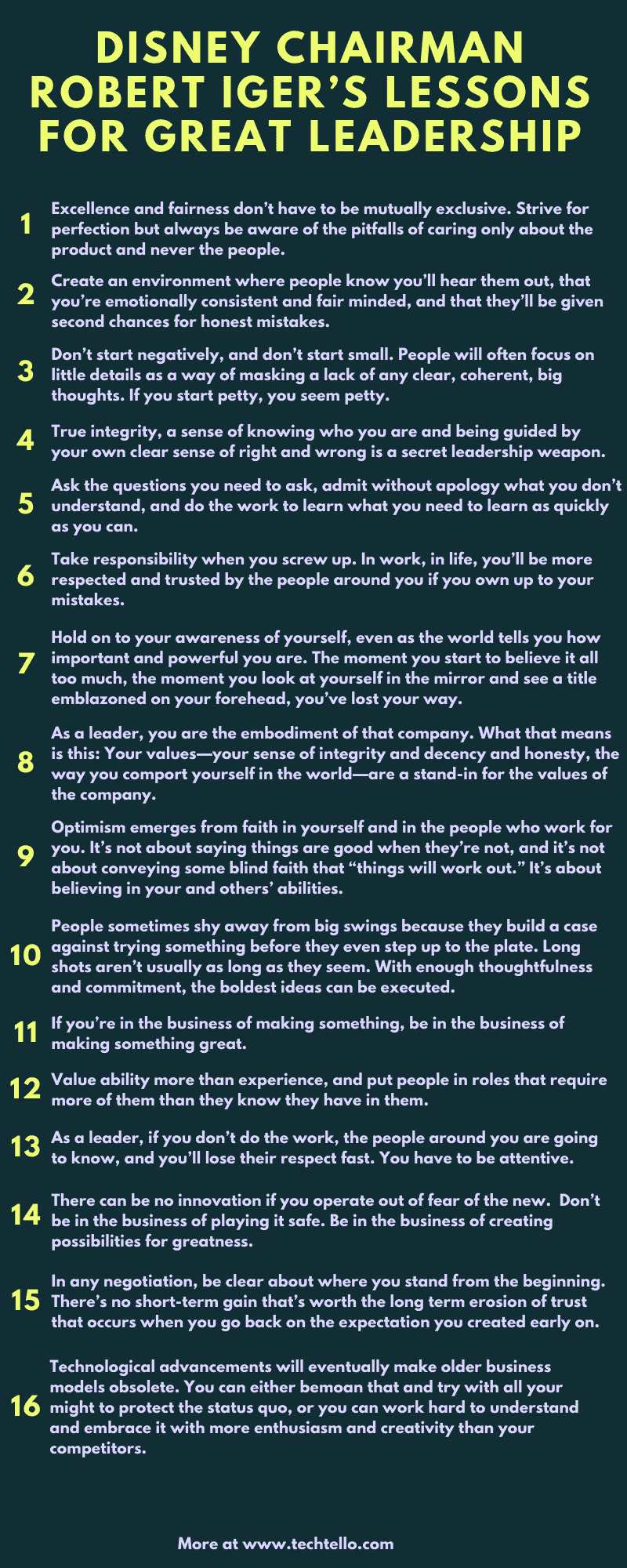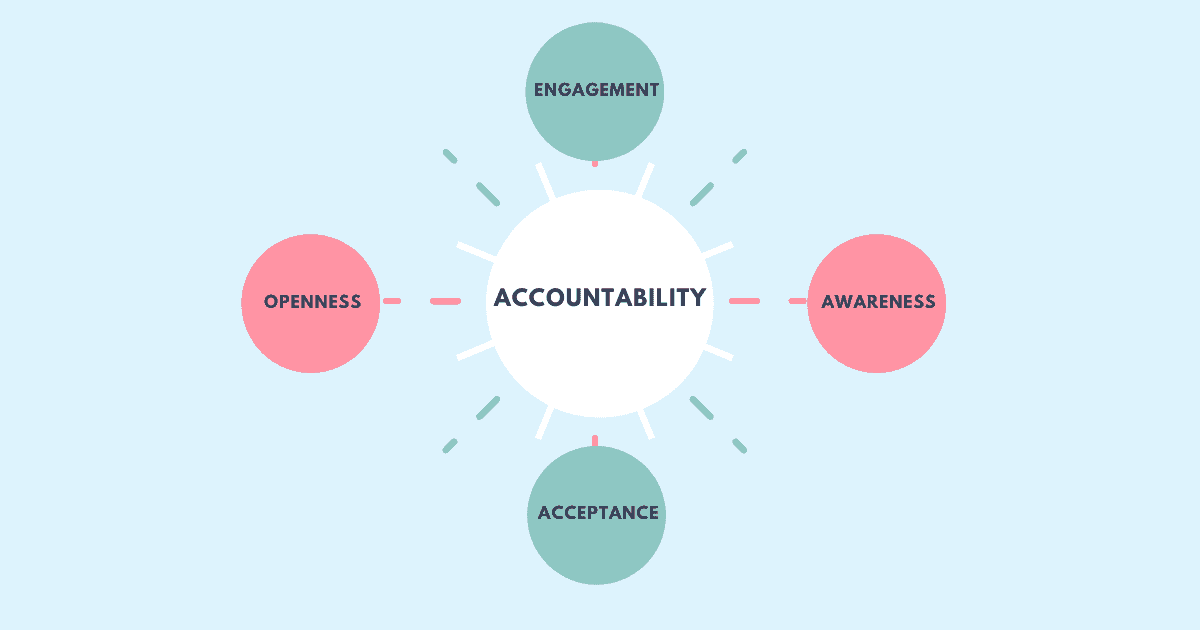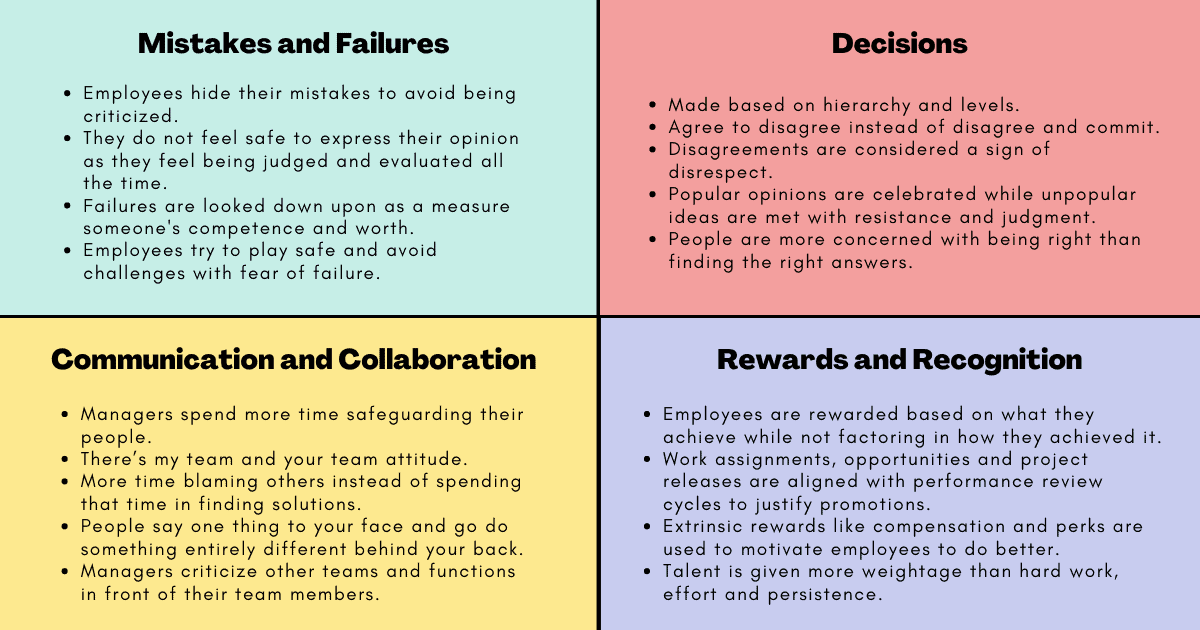Disney Chairman Robert Iger’s Lessons For Great Leadership

Robert Iger, now Executive Chairman of The Walt Disney Company is the former CEO of Disney. During his 15 years as CEO of Disney and as President of ABC Television prior to that, he led the company to amazing new heights. Under his leadership, Disney’s market capitalization increased from $48 billion to $257 billion. He oversaw the acquisition of Pixar in 2006, Marvel entertainment in 2009 and many more after that. He is the perfect exemplar of a leader who has proved himself over an extended period of time.
But, Robert Iger’s rise to the top wasn’t an easy one.
He was raised in a small house on Long Island with his younger sister. His dad, a Navy veteran suffered from manic depression and his mom was a constant worrier. Instead of letting the challenges and setbacks in his life push him back, he turned them into learning opportunities.
He started working in eight grade shoveling snow, babysitting and working as a stock boy in a hardware store. At fifteen, he got a job as the summer janitor in his school district. It involved cleaning every heater in every classroom, then moving on to the bottom of every desk, making sure they were gum-free when the school year started. Cleaning gum from thousands of desks built a tolerance for monotony. His dad’s obsessiveness about spending time productively served him well later when he was required to manage his own time. His mom’s anxiety about the future instilled an opposite sense of fearlessness about trying and failing.
He started his career at ABC in 1974 when he was 23 years old as a studio supervisor for ABC Television with $150 per week which was the lowest on the ABC ladder in those days. From studio supervisor managing shows to operations supervisor at ABC sports to Vice President at ABC Sports to President of ABC entertainment to President of Disney and then CEO of Disney for 15 years, it’s one hell of a ride. The demanding hours and the workload from his initial days created a work ethic that stayed with him throughout his career.
In his book, The Ride of a Lifetime, he writes about his personal leadership philosophy that has guided him in the last 45 years. These are the lessons that every leader needs to embody. Here are the direct leadership lessons as he puts them categorized (by me) into 7 key areas:
Thoughtfulness as a leader
As a leader you not only need to be considerate of the people you work with, you also need to understand what they need. Fundamental principles from Robert Iger to live by when working with others:
- Excellence and fairness don’t have to be mutually exclusive. Strive for perfection but always be aware of the pitfalls of caring only about the product and never the people.
- Be decent to people. Treat everyone with fairness and empathy. This doesn’t mean that you lower your expectations or convey the message that mistakes don’t matter. It means that you create an environment where people know you’ll hear them out, that you’re emotionally consistent and fair minded, and that they’ll be given second chances for honest mistakes.
- Don’t start negatively, and don’t start small. People will often focus on little details as a way of masking a lack of any clear, coherent, big thoughts. If you start petty, you seem petty.
- You have to convey your priorities clearly and repeatedly. If you don’t articulate your priorities clearly, then the people around you don’t know what their own should be. Time and energy and capital get wasted.
- You can do a lot for the morale of the people around you (and therefore the people around them) just by taking the guesswork out of their day-to-day life. A lot of work is complex and requires intense amounts of focus and energy, but this kind of messaging is fairly simple: This is where we want to be. This is how we’re going to get there.
- There have been many times over the years when I’ve had to deliver difficult news to accomplished people, some of whom were friends, and some of whom had been unable to flourish in positions that I had put them in. I try to be as direct about the problem as possible, explaining what wasn’t working and why I didn’t think it was going to change. There’s a kind of euphemistic corporate language that is often deployed in those situations, and that has always struck me as offensive. If you respect the person, then you owe them a clear explanation for the decision you’re making. There’s no way for the conversation not to be painful, but at least it can be honest
Personal growth as a leader
Being a leader requires a high degree of self-awareness with a willingness to constantly strive for improvement. Principles from Robert Iger to grow as a leader:
- True integrity—a sense of knowing who you are and being guided by your own clear sense of right and wrong—is a kind of secret leadership weapon. If you trust your own instincts and treat people with respect, the company will come to represent the values you live by.
- Ask the questions you need to ask, admit without apology what you don’t understand, and do the work to learn what you need to learn as quickly as you can.
- Take responsibility when you screw up. In work, in life, you’ll be more respected and trusted by the people around you if you own up to your mistakes. It’s impossible to avoid them; but it is possible to acknowledge them, learn from them, and set an example that it’s okay to get things wrong sometimes.
- Don’t let ambition get ahead of opportunity. By fixating on a future job or project, you become impatient with where you are. You don’t tend enough to the responsibilities you do have, and so ambition can become counterproductive. It’s important to know how to find the balance—do the job you have well; be patient; look for opportunities to pitch in and expand and grow; and make yourself one of the people, through attitude and energy and focus, whom your bosses feel they have to turn to when an opportunity arises.
- Pessimism leads to paranoia, which leads to defensiveness, which leads to risk aversion.
- It’s easy to be optimistic when everyone is telling you you’re great. It’s much harder, and much more necessary, when your sense of yourself is on the line.
- If something doesn’t feel right to you, it won’t be right for you.
- Hold on to your awareness of yourself, even as the world tells you how important and powerful you are. The moment you start to believe it all too much, the moment you look at yourself in the mirror and see a title emblazoned on your forehead, you’ve lost your way.
Creating a strong positive culture as a leader
Leaders play a crucial role in shaping the culture of an organization. How they act and what they say consciously and subconsciously impacts the culture of an entire organization. Principles from Robert Iger to create a powerful and empowering culture:
- As a leader, you are the embodiment of that company. What that means is this: Your values—your sense of integrity and decency and honesty, the way you comport yourself in the world—are a stand-in for the values of the company. You can be the head of a seven-person organization or a quartermillion-person organization, and the same truth holds: what people think of you is what they’ll think of your company.
- When the people at the top of a company have a dysfunctional relationship, there’s no way that the rest of the company can be functional. It’s like having two parents who fight all the time. The kids know, and they start to reflect the animosity back onto the parents and at each other.
- If you walk up and down the halls constantly telling people “the sky is falling,” a sense of doom and gloom will, over time, permeate the company. You can’t communicate pessimism to the people around you. It’s ruinous to morale. No one wants to follow a pessimist.
- Optimism emerges from faith in yourself and in the people who work for you. It’s not about saying things are good when they’re not, and it’s not about conveying some blind faith that “things will work out.” It’s about believing in your and others’ abilities.
- A company’s reputation is the sum total of the actions of its people and the quality of its products. You have to demand integrity from your people and your products at all times.
- It’s not good to have power for too long. You don’t realize the way your voice seems to boom louder than every other voice in the room. You get used to people withholding their opinions until they hear what you have to say. People are afraid to bring ideas to you, afraid to dissent, afraid to engage. This can happen even to the most well-intentioned leaders. You have to work consciously and actively to fend off its corrosive effects.
- Michael Eisner used to say, “micromanaging is underrated.” I agree with him—to a point. Sweating the details can show how much you care. “Great” is often a collection of very small things, after all. The downside of micromanagement is that it can be stultifying, and it can reinforce the feeling that you don’t trust the people who work for you.
Future orientation as a leader
Every leader needs to be effective first and that requires consciously focusing on the future needs of your organization. Principles from Robert Iger to lead your organization to success and growth:
- Too often, we lead from a place of fear rather than courage, stubbornly trying to build a bulwark to protect old models that can’t possibly survive the sea change that is under way. It’s hard to look at your current models, sometimes even ones that are profitable in the moment, and make a decision to undermine them in order to face the change that’s coming.
- People sometimes shy away from big swings because they build a case against trying something before they even step up to the plate. Long shots aren’t usually as long as they seem. With enough thoughtfulness and commitment, the boldest ideas can be executed.
- Technological advancements will eventually make older business models obsolete. You can either bemoan that and try with all your might to protect the status quo, or you can work hard to understand and embrace it with more enthusiasm and creativity than your competitors.
- It should be about the future, not the past.
- You have to do the homework. You have to be prepared. You certainly can’t make a major acquisition, for example, without building the necessary models to help you determine whether a deal is the right one. But you also have to recognize that there is never 100 percent certainty. No matter how much data you’ve been given, it’s still, ultimately, a risk, and the decision to take that risk or not comes down to one person’s instinct.
- A lot of companies acquire others without much sensitivity toward what they’re really buying. They think they’re getting physical assets or manufacturing assets or intellectual property (in some industries, that’s more true than others). But usually what they’re really acquiring is people. In a creative business, that’s where the value lies.
- If you’re in the business of making something, be in the business of making something great.
- The decision to disrupt a business model that is working for you requires no small amount of courage. It means intentionally taking on short-term losses in the hope that a long-term risk will pay off. Routines and priorities get disrupted. Traditional ways of doing business get slowly marginalized and eroded—and start to lose money—as a new model takes over. That’s a big ask, in terms of a company’s culture and mindset. When you do it, you’re saying to people who for their entire careers have been compensated based on the success of their traditional business: “Don’t worry about that too much anymore. Worry about this instead.” But this isn’t profitable yet, and won’t be for a while. Deal with this kind of uncertainty by going back to basics: Lay out your strategic priorities clearly. Remain optimistic in the face of the unknown. And be accessible and fair-minded to people whose work lives are being thrown into disarray.
Hiring and people growth as a leader
One of the most important jobs of a leader is to bring out the best in others. Principles from Robert Iger to hire and grow talent:
- When hiring, try to surround yourself with people who are good in addition to being good at what they do. Genuine decency—an instinct for fairness and openness and mutual respect—is a rarer commodity in business than it should be, and you should look for it in the people you hire and nurture it in the people who work for you.
- Value ability more than experience, and put people in roles that require more of them than they know they have in them.
- We all want to believe we’re indispensable. You have to be self-aware enough that you don’t cling to the notion that you are the only person who can do this job. At its essence, good leadership isn’t about being indispensable; it’s about helping others be prepared to step into your shoes—giving them access to your own decision-making, identifying the skills they need to develop and helping them improve, and sometimes being honest with them about why they’re not ready for the next step up.
- Projecting your anxiety onto your team is counterproductive. It’s subtle, but there’s a difference between communicating that you share their stress—that you’re in it with them—and communicating that you need them to deliver in order to alleviate your stress.
- As a leader, if you don’t do the work, the people around you are going to know, and you’ll lose their respect fast. You have to be attentive. You often have to sit through meetings that, if given the choice, you might choose not to sit through. You have to listen to other people’s problems and help find solutions. It’s all part of the job.
Creativity and innovation as a leader
Creating an environment in which people and business can thrive does take a lot of work. Apply these principles from Robert Iger to encourage creativity and innovation in your organization:
- Now more than ever: innovate or die. There can be no innovation if you operate out of fear of the new.
- I talk a lot about “the relentless pursuit of perfection.” In practice, this can mean a lot of things, and it’s hard to define. It’s a mindset, more than a specific set of rules. It’s not about perfectionism at all costs. It’s about creating an environment in which people refuse to accept mediocrity. It’s about pushing back against the urge to say that “good enough” is good enough.
- Managing creativity is an art, not a science. When giving notes, be mindful of how much of themselves the person you’re speaking to has poured into the project and how much is at stake for them.
- Of all the lessons I learned in my first year running prime time at ABC, the acceptance that creativity isn’t a science was the most profound. I became comfortable with failure—not with lack of effort, but with the fact that if you want innovation, you need to grant permission to fail.
- Don’t be in the business of playing it safe. Be in the business of creating possibilities for greatness.
- My former boss Dan Burke once handed me a note that said: “Avoid getting into the business of manufacturing trombone oil. You may become the greatest trombone-oil manufacturer in the world, but in the end, the world only consumes a few quarts of trombone oil a year!” He was telling me not to invest in small projects that would sap my and the company’s resources and not give much back. I still have that note in my desk, and I use it when talking to our executives about what to pursue and where to put their energy.
Negotiating as a leader
Leaders are required to negotiate all the time. Ability to negotiate well requires a lot of practice, but it starts with a few fundamental principles. Principles from Robert Iger when negotiating:
- In any negotiation, be clear about where you stand from the beginning. There’s no short-term gain that’s worth the long term erosion of trust that occurs when you go back on the expectation you created early on.
- Most deals are personal. This is even more true if you’re negotiating with someone over something he or she has created. You have to know what you want out of any deal, but to get there you also need be aware of what’s at stake for the other person.
- Treating others with respect is an undervalued currency when it comes to negotiating. A little respect goes a long way, and the absence of it can be very costly.
Finally, he says “You have to approach your work and life with a sense of genuine humility. The success I’ve enjoyed has been due in part to my own efforts, but it’s also been due to so much beyond me, the efforts and support and examples of so many people, and to twists of fate beyond my control.”






























